by Lorri | May 22, 2013 | UnCorked
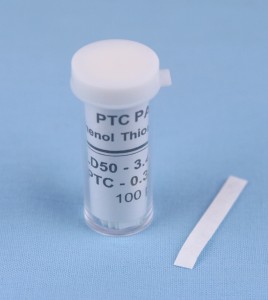 In the past, wine, not food, was considered the culprit when it came to unsuccessful food and wine pairings. But realistically, almost every wine produced today will work with food. Of course there will still be the occasional horrible combination, not unlike having your morning orange juice after brushing your teeth.
In the past, wine, not food, was considered the culprit when it came to unsuccessful food and wine pairings. But realistically, almost every wine produced today will work with food. Of course there will still be the occasional horrible combination, not unlike having your morning orange juice after brushing your teeth.
The impact of food on wine is almost entirely determined by the balance of primary tastes in the food: sweet, salt, sour, savory or bitter. Certain foods will change when matched with certain wines.
But what if these tastes were perceived dramatically differently by each of us? Recently I watched a group of tasters comparing their tolerance for bitterness. Each was given a PTC Strip (phenylthiocarbamide) and asked to place it on their tongue. (The strips can be bought at most online school science project vendors.) It was startling to see how quickly some wanted to remove the strip. Others in the room kept it in for minutes, unable to detect bitterness at all. The everyday example could be how some people drink only espresso or dark black coffee while others add cream or sugar.
Because we all vary in our sensitivities and preferences there is no simple answer to what wine goes best with what food, but some dishes are higher risk than others. What this simple exercise shows us is we all have different tastes and react differently when wine and food are paired. But that doesn’t mean every new pairing is a crap shoot. The key to successful pairing experiments is knowing which foods are more likely to react to wine and understanding which pairings are high risk and which are low.
One of the highest risk factors is a food’s sweetness. Sweet foods can increase bitterness, acidity, astringency and even create a burning sensation when paired with wine. The reaction can also decrease the wine’s body, richness and sweetness. Sweetness is the No. 1 culprit for creating unpleasant interactions. It is because of this that we have the standing suggestion that the wine should always be sweeter than the food.
On the other end of the risk spectrum is salt. Salt is one of the most wine-friendly components of food, and can help soften some of the harsher elements in wine. Salt will increase the perception of body in the wine and decrease the perception of bitterness and acidity.
This week I encourage you to experiment with sweet and salt while pairing your wines.
THE VALUE
- 2011 Pacific Rim Columbia Valley Riesling, Washington (about $14 retail)
THE SPLURGE
- NV Sandeman Porto Tawny 10 Years Old, Portugal (about $40 retail)
by Lorri | May 15, 2013 | UnCorked
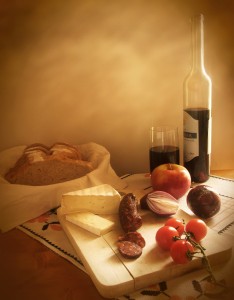 One of my favorite wine and food pairing quotations is from a book titled London at Table: Or How, When, and Where to Dine and Order a Dinner, and Where to Avoid Dining, published in 1851 at the peak of the Industrial Revolution. This was a time when the word “Victorian” was being used as a self-expression with a new generation of wealthy businessmen and wives looking for status. An ideal strategy to get higher on this ladder was to host lavish, entertaining events at home or regal restaurants. Many families began hiring servants to assist in food preparation and service. And traditional buffet-style dining shifted to stately seated dinners with multiple-course processions. This opulent style of table dining allowed for, and arguably called for, each food course to be served with a different wine.
One of my favorite wine and food pairing quotations is from a book titled London at Table: Or How, When, and Where to Dine and Order a Dinner, and Where to Avoid Dining, published in 1851 at the peak of the Industrial Revolution. This was a time when the word “Victorian” was being used as a self-expression with a new generation of wealthy businessmen and wives looking for status. An ideal strategy to get higher on this ladder was to host lavish, entertaining events at home or regal restaurants. Many families began hiring servants to assist in food preparation and service. And traditional buffet-style dining shifted to stately seated dinners with multiple-course processions. This opulent style of table dining allowed for, and arguably called for, each food course to be served with a different wine.
With this new style of entertaining came the need for the creation of wine and food rules, or etiquette. Writers laid out these rules and some of the creators were even considered the “experts.” As you can imagine most of these rules were not presented as suggestions but stern instructions on what to do, and most without explanation. These etiquette-eager newcomers took to the direction without misstep.
London at Table was one of these rule books.
My favorite quotation, making me smile each time I read it: “In order to give the cook fair play, the fish should never be served with the soup, it’s a distinct and important course.”
The author goes on to point out vulgarisms to be avoided, “With white fish, one glass only of Hock or a Moselle Cup (a punch, mixing Riesling and sherry) With salmon either claret or port.”
“Champagne may be served throughout to the females at the table, as it’s a favorite with the ladies, a prevailing weakness of the day,” but even so never with the roast.
Of course, today we know the rules have become more relaxed but many still stand in the way of great food and wine combinations. Over the next few weeks of columns we’re going to explore some changes in food and wine pairing rules, starting with some fun homework to better understand why the rules are not always so simple.
The homework: Send me your best nontraditional pairings and your thoughts on these.
Grilled Salmon and Pinot Noir
THE VALUE
- 2011 Stemmari Pinot Noir, Italy (about $9 retail)
THE SPLURGE
- 2010 Renteria Russian River Pinot Noir, California (about $40 retail)
Chinese Egg Rolls and Pinot Gris
THE VALUE
- 2011 Adelsheim Pinot Gris, Oregon (about $14 retail)
THE SPLURGE
- 2011 Trimbach Pinot Gris, France (about $27 retail)
Popcorn and Champagne / Sparkling Wine
THE VALUE
- NV Piper Sonoma Brut Sparkling, California (about $15 retail)
THE SPLURGE
- NV Roederer Estate L’Ermitage, California (about $45 retail)
by Lorri | May 8, 2013 | UnCorked
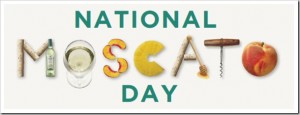 Add to your calendar another day to celebrate – this one for the love of a grape. Moscato has hit a stride with consumers and continues to be the fastest-growing grape varietal in the United States. It’s so popular that Thursday is National Moscato Day.
Add to your calendar another day to celebrate – this one for the love of a grape. Moscato has hit a stride with consumers and continues to be the fastest-growing grape varietal in the United States. It’s so popular that Thursday is National Moscato Day.
The style just seems to work for many American palates with its light, bubbly sweet tastes. It’s known for its surprising perfume-like fragrance. Even as a low-alcohol, straightforward wine the aromatics in most moscato have layers of tropical fruits, peach, orange blossom and even honeysuckle. It not only tastes refreshing, the easy-going wine pairs easily with many cheeses and spicy foods.
Most of us don’t need a reason to have a chilled glass of Moscato but lots of fun is to be had Thursday, starting with Gallo Family Vineyards, who will be hosting a National Moscato Day Twitter party from 8 to 9 p.m. It is offering an open invitation for anyone looking to learn more about the wine and different ways to enjoy it. By joining the conversation using the hashtag #MoscatoDay on Twitter, people can share and gather hosting tips, food-pairing suggestions and wine facts. Gallo is bringing in a few food and wine experts to join in the discussion, making the party even better.
Sutter Home Family Vineyards are also joining in the fun with a Moscato Day Sweepstakes from today to May 31. Fans are invited to enter for a chance to win one of 100 Moscato Prize Packs that contain a set of six charms, four plastic wine glasses, a sparkling wine stopper and a moscato cocktail recipe booklet. Sutter Home will also be hosting a Twitter Party, join in @SutterHome for #sutter-HomeMoscato from 7 to 8 p.m. Thursday. Eight people will be randomly entered to win a prize during the live Twitter party sweepstakes. Visit nationalmoscatoday.com for more information.
THE VALUES
- 2011 Gallo Family Vineyards Moscato, California (about $6 retail)
- 2011 Sutter Home Family Vineyards Moscato, California (about $6 retail)
- 2001 Mionetto Vineyards, Italy (about $14 retail)
- 2011 Woodbridge by Robert Mondavi Moscato, California (about $8 retail)
- 2011 Ecco Domani Moscato, Italy (about $15 retail)THE SPLURGES
- 2011 St. Supery Moscato, California (about $22 retail)
- 2011 Marco Negri Moscato d’Asti, Italy (about $22 retail)
by Lorri | May 1, 2013 | UnCorked
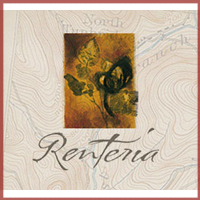 Oscar Renteria, of Renteria Wines, and I had an immediate connection but, oddly, not on the subject of spectacular wine but our shared stories of farming.
Oscar Renteria, of Renteria Wines, and I had an immediate connection but, oddly, not on the subject of spectacular wine but our shared stories of farming.
I don’t think of the term “farming” as one usually showing up on the back labels of cult wines, but it means a lot to those who understand not only the wine but what the vineyard and land give to it. And it is in this understanding that our family stories – grapes growing in the soils of Napa Valley and cotton and soybeans in south Arkansas – come together.
Oscar’s father, Salvador Renteria, is the founder of their family’s legacy to the American wine industry. Salvador arrived in Napa Valley from Mexico in 1962, first picking grapes as afield laborer and later working as vineyard supervisor. In just a few short years his talents and knowledge of the terroir were evident as he went on to oversee some of the most recognized vineyards in the world, Silverado, Cuvaison, Clos Pegase and Beaulieu vineyards, to name a few. He was one of the first in Napa Valley to employ trellising and canopy management. His experiment sin the field led to innovative methods and improvements. In 1987 Salvador started his own management company.
Oscar took over the family business in 1993. He had worked in the vineyard alongside his father, gaining an understanding of his father’s passion and approach. The experience guided him in the direction he charted for Renteria Vineyard Management, Inc., the third largest vineyard management company in the northern Bay Area.
At our tasting Oscar clearly enjoyed talking about his family’s wines, but it was when he talked about Renteria’s future that the excitement in his voice peaked. He is convinced that new ways of using technology are key. Oscar believes combining his father’s ideas with modern innovations will lead to the best quality grapes a vineyard can produce.
Those of us in the wine industry call this terroir, many field workers call it the land and then some of us simply refer to it as the indisputable love of the land, soil, and nature: farming.
- 2009 Renteria Napa Valley Cabernet Sauvignon, California (about $30 retail)
- 2008 Renteria Russian River Pinot Noir, California (about $40 retail)
by Lorri | Apr 24, 2013 | UnCorked
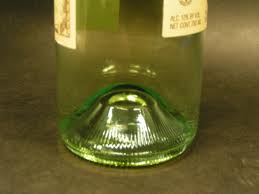 In my previous post I outlined the reasons for different shapes of wine bottles. In this post I’ll explain the reason behind the bottle’s other features.
In my previous post I outlined the reasons for different shapes of wine bottles. In this post I’ll explain the reason behind the bottle’s other features.
The punt of a wine bottle – the deep indention in the bottom of the bottle – is the most questioned of modern bottle shapes. In early bottles, punts added strength to the bottom of the glass and helped stabilize the base, as hand-blown glass can be wrought with imperfections. Punts are common on sparkling wine bottles because it was common practice in Champagne, France, to stack the bottles neck to punt. Punts can also make a wine bottle appear bigger and more impressive. Another function is that it adds an elegant placement for the sommelier’s thumb while pouring in fine dining situations. However, its main purpose today is cosmetic.
The size and shape of sparkling wine bottles has clearly defined roots. In the early days of Champagne-making, it was a common occurrence for bottles to explode from the pressure (roughly 90 pounds per square inch) generated during fermentation. Some workers even wore protective gear for this reason. Champagne bottles are typically made of thick glass with a pronounced punt. It’s not necessary in modern bottling but is an ingrained tradition we will most likely not see changed.
Although all wine is best kept in dark-colored glass, variations in bottle colors can also be explained by region.Generally, whites and roses are in clear glass, while reds are in darker glass. Dark bottles, either because of regional tradition or production, are produced in shades that range from yellow-green and pale blue-green to almost black. In Germany, brown glass was used to differentiate wine from the Rhine region versus the green bottle from Mosel. Blue glass bottles became a popular alternative about 30 years ago.
The variations in size of the early bottles can be attributed to the challenges of early glass-making. In early wine history, most wine was measured out and then put into a bottle, so bottle size didn’t matter much. But for modern bottling we now have precise regulations, with 750 milliliters being a standard size.
- GREEN GLASS 2011 Domaines Schlumberger Pinot Blanc, France (about $20 retail)
- BROWN GLASS 2010 Frank Family Cabernet Sauvignon, California (about $48 retail)
- CLEAR GLASS 2010 Robert Mondavi Fume Blanc, California (about $20 retail)
by Lorri | Apr 17, 2013 | UnCorked
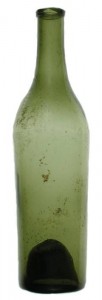 The array of bottle designs has an intriguing history.
The array of bottle designs has an intriguing history.
The modern wine bottle was a journey of man made evolution. The earliest bottles were pretty straightforward: Any vessel that could hold and serve wine, be it pottery, leather or even carved wood, was used. Though glass vessels have been used for wine since at least the Roman times, they didn’t become commonplace until the 17th century.
The shape of early wine bottles resembled an onion – a wide, round body with a short neck. Over time, as glass making techniques advanced and stronger bottles were produced , they became taller and narrower. These elongated bottles allowed vintners to store more of their product. In the 1700s, the practice of binning ( storing a bottle on its side) was created. This storage method was ideal because the cork would stay wet and swollen, ensuring a good seal.
But even with the slow transformation from short and round to tall and narrow, specific bottle shapes traditionally are commonly associated with certain regions or styles, such as the high-shouldered “Bordeaux” bottle, the sloped “Burgundy” bottle and the tall, slender “Hoch” (literally high) bottle for German wines. With the globalization of wine production, bottle shape became away to indicate what type of wine was inside. Generally you find red Bordeaux varietals such as cabernet sauvignon and merlot and whites like sauvignon blanc and semillon in the Bordeaux shape, regardless of where the grapes were grown. The same is generally true for Burgundy’s main varietals of pinot noir and chardonnay as well as the German Hoch bottle for Riesling, Gewurztraminer and Alsace wines.
THE “BORDEAUX” SHAPE
- 2010 Francis Coppola Claret Cabernet Sauvignon, California (about $14 retail)
THE “BURGUNDY” SHAPE
- 2010 Schug Pinot Noir, California (about $19 retail)
THE “HOCH” SHAPE
- 2011 Chateau Ste. Michelle Riesling, Washington (about $12 retail)
 In the past, wine, not food, was considered the culprit when it came to unsuccessful food and wine pairings. But realistically, almost every wine produced today will work with food. Of course there will still be the occasional horrible combination, not unlike having your morning orange juice after brushing your teeth.
In the past, wine, not food, was considered the culprit when it came to unsuccessful food and wine pairings. But realistically, almost every wine produced today will work with food. Of course there will still be the occasional horrible combination, not unlike having your morning orange juice after brushing your teeth. One of my favorite wine and food pairing quotations is from a book titled London at Table: Or How, When, and Where to Dine and Order a Dinner, and Where to Avoid Dining, published in 1851 at the peak of the Industrial Revolution. This was a time when the word “Victorian” was being used as a self-expression with a new generation of wealthy businessmen and wives looking for status. An ideal strategy to get higher on this ladder was to host lavish, entertaining events at home or regal restaurants. Many families began hiring servants to assist in food preparation and service. And traditional buffet-style dining shifted to stately seated dinners with multiple-course processions. This opulent style of table dining allowed for, and arguably called for, each food course to be served with a different wine.
One of my favorite wine and food pairing quotations is from a book titled London at Table: Or How, When, and Where to Dine and Order a Dinner, and Where to Avoid Dining, published in 1851 at the peak of the Industrial Revolution. This was a time when the word “Victorian” was being used as a self-expression with a new generation of wealthy businessmen and wives looking for status. An ideal strategy to get higher on this ladder was to host lavish, entertaining events at home or regal restaurants. Many families began hiring servants to assist in food preparation and service. And traditional buffet-style dining shifted to stately seated dinners with multiple-course processions. This opulent style of table dining allowed for, and arguably called for, each food course to be served with a different wine. Add to your calendar another day to celebrate – this one for the love of a grape. Moscato has hit a stride with consumers and continues to be the fastest-growing grape varietal in the United States. It’s so popular that Thursday is National Moscato Day.
Add to your calendar another day to celebrate – this one for the love of a grape. Moscato has hit a stride with consumers and continues to be the fastest-growing grape varietal in the United States. It’s so popular that Thursday is National Moscato Day. Oscar Renteria, of Renteria Wines, and I had an immediate connection but, oddly, not on the subject of spectacular wine but our shared stories of farming.
Oscar Renteria, of Renteria Wines, and I had an immediate connection but, oddly, not on the subject of spectacular wine but our shared stories of farming. In my previous post I outlined the reasons for different shapes of wine bottles. In this post I’ll explain the reason behind the bottle’s other features.
In my previous post I outlined the reasons for different shapes of wine bottles. In this post I’ll explain the reason behind the bottle’s other features. The array of bottle designs has an intriguing history.
The array of bottle designs has an intriguing history.